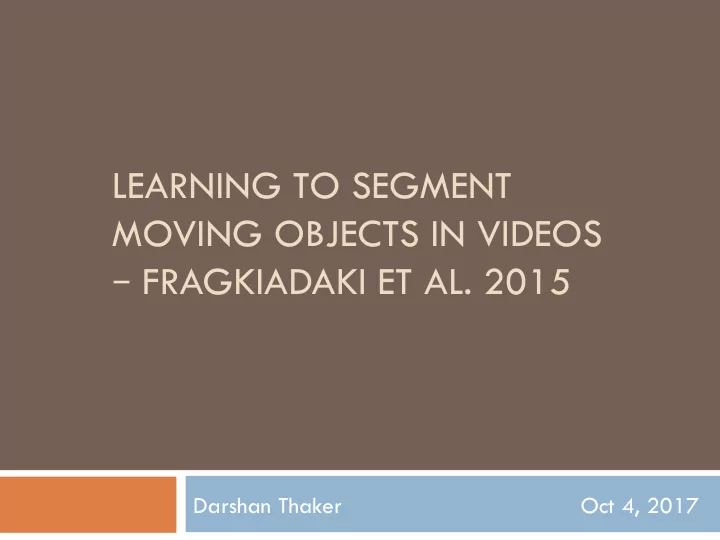

LEARNING TO SEGMENT MOVING OBJECTS IN VIDEOS – FRAGKIADAKI ET AL. 2015 Darshan Thaker Oct 4, 2017
Problem Statement ¨ Moving object segmentation in videos ¤ Applications: security tracking, pedestrian detection, etc. GIF credit: https://giphy.com/search/football-is-back
Brief background on optical flow ¨ Optical flow problem: estimate pixel motion from image H to image I? ¨ Use large displacement optical flow approach [1] ¤ Output can be interpreted as three channel image ¨ Flow bleeding : Optical flow misaligns with true object boundaries [1]: T. Brox and J. Malik. Large displacement optical flow Slide credit: Steve Seitz
Overview of Approach ¨ Moving Object Proposals (MOPs) ¨ Moving Objectness Detector on optical flow + RGB channels ¨ Obtain dense point trajectories ¤ Intersection of trajectories with MOPs yields foreground and background segmentation ¨ Propagate pixel labels to nearby frames using random walks ¨ Generate proposals by clustering superpixels across frames
Approach: Step 1 Ground Truth Note: this uses structured Video forest boundary detector Frame Image boundaries Image credit: Fragkiadaki et. al
Approach: Step 1 Ground Truth Note: this uses structured Video forest boundary detector Frame Static Object Image boundaries Proposals Image credit: Fragkiadaki et. al
Approach: Step 1 Ground Truth Optical flow Note: this uses structured Video forest boundary detector Frame Static Object Image boundaries Proposals Image credit: Fragkiadaki et. al
Approach: Step 1 Ground Truth Optical Boundaries flow Note: this uses structured Video forest boundary detector Frame Static Object Image boundaries Proposals Image credit: Fragkiadaki et. al
Approach: Step 1 Ground Truth Moving Object Optical Boundaries Proposals flow Note: this uses structured Note: this uses geodesic object Video forest boundary detector proposals for segmentation Frame Static Object Image boundaries Proposals Image credit: Fragkiadaki et. al
Approach: Step 2a Outputs Moving Objectness Detector score in with dual pathway architecture [0, 1] on optical flow + RGB channels Moving Object Proposal Image credit: Fragkiadaki et. al
Approach: Step 2b ¨ Weights in each network stack initialized to pretrained Imagenet 200 category network (R-CNN) ¨ Finetuned with small collection of moving object boxes + background boxes from VSB100 and Moseg video datasets Image credit: Fragkiadaki et. al
Approach: Step 3 Obtain dense point trajectories by linking optical flow fields. Image credit: Fragkiadaki et. Al (https://www.cs.cmu.edu/~katef/videoseg.html)
Approach: Step 3 N = # trajectories 0.5 1 0.25 … … … … … N N … … … … … … … … Obtain dense point trajectories N by linking optical flow fields. Compute pairwise trajectory affinity matrix A (affinity = fn of maximum velocity difference) Image credit: Fragkiadaki et. Al (https://www.cs.cmu.edu/~katef/videoseg.html)
Approach: Step 4a Moving Object Proposal Image credit: Fragkiadaki et. al
Approach: Step 4a Moving Object Proposal Trajectories intersection with MOP background foreground Image credit: Fragkiadaki et. al
Approach: Step 4a Moving Object Proposal Trajectories intersection with MOP background foreground ¨ Problem: Frames around F temporally might not have apparent motion (trajectories not overlap with MOP as shown below) Image credit: Fragkiadaki et. al
Approach: Step 4b ¨ Propagate pixel labels through trajectory motion affinities using Random Walkers and minimizing cost function x denotes trajectory labels (fg or bg) ¨ Perform series of label diffusions (~50) to propagate trajectory labels and get better segmentations Image credit: Fragkiadaki et. al
Approach: Step 5 ¨ Map trajectory clusters to pixels used weighted average over superpixels that extend across multiple frames ¨ Final goal: Maximize Intersection over Union (IOU) of spatio- temporal tubes with ground truth objects using fewest tube proposals Image credit: Fragkiadaki et. al
Datasets ¨ VSB100 ¤ 100 HD human-annotated videos ¤ Many crowded scenes (parade, cycling, etc.) n More challenging ¨ Moseg ¤ 59 video sequences (720 frames) with pixel-accurate segmentation ¤ Scenes from movie “Miss Marple” + cars and animals ¤ Uncluttered scenes (one or two objects per video)
Experiments/Results Image credit: Fragkiadaki et. al
Experiments/Results Image credit: Fragkiadaki et. Al (https://www.cs.cmu.edu/~katef/videolearn.html)
Advantages ¨ Moving Objectness Detector learns to suppress these cases (in red) ¨ Not all frames will have moving objects because objects are not constantly in motion ¤ Trajectory clustering propagates segmentation to frames with little motion ¨ Bridges gap between “bottom-up” motion segmentation and object-specific detectors Image credit: Fragkiadaki et. Al (https://www.cs.cmu.edu/~katef/posters/CVPR2015_LearnVideoSegment.pdf)
Disadvantages/Extensions ¨ Same boundary detector used on both optical flow map and video frame ¨ Temporal Fragmentations caused by large motion or full object occlusions ¨ Inaccurate mapping of trajectory clusters to pixel tubes
Summary Points ¨ Video segmentation method with great looking results that are rarely undersegmented ¨ Opinion: Frame by frame MOP approach seems inherently flawed ¤ Input to MOD could be n consecutive frames itself ¨ Trajectory clustering is noisy ¤ Random walk depends on dataset and how long objects typically remain static
Recommend
More recommend